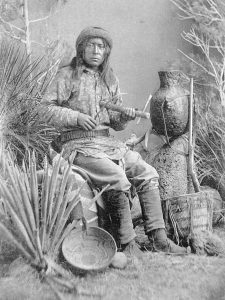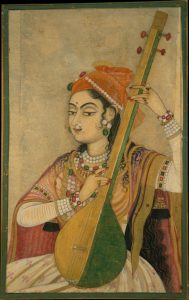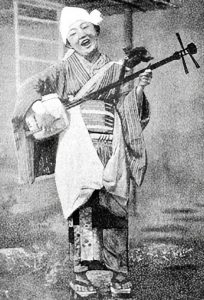Appendix: Music of the World
Introduction
As we have seen, music in Western culture is part of a rich tradition beginning with the Greeks, developing through the music of the church, and eventually resulting in the music we hear today. But have you ever considered what music is like in non-Western cultures? As with Western music, the various cultures across the globe have their own traditions, musical styles, practices, and rules that are often vastly different from the music many Americans are used to. The following is a sample of many different music styles from all over the world. This review will be a very cursory introduction to only a handful of the thousands of musical styles that exist across the globe with which you may not be familiar. Bear in mind that many of these musical traditions date back hundreds, and sometimes thousands, of years and deserve further exploration outside of the context of this textbook. Beyond these examples, much more music is available to you through YouTube. In this review, we will primarily focus on the musical elements of melody, rhythm, instrumentation, and harmony, and describe the processes that different societies use to combine these elements.
Readers are also encouraged to use the following open educational resources for further exploration and study in World Music.
- Listening to the World: A Brief Survey of World Music by Antoni Pizà
- Music in Global America by Marc Thorman
- Beyond the Classroom: World Music from the Musician’s Point of View by Dr. Howard Spring and Dr. Ryan Bruce
North America
1. Native American Music
Throughout history, certain cultures have had more opportunity to develop music than others. Often, the effort required to hunt, gather, or raise food has been all encompassing and has left little time for leisure or artistic pursuits. Therefore, music was only performed when the people thought it was necessary or important. Like many other cultures, traditional Native American music was normally performed as a part of important rituals meant to ask specific deities for various benefits, such as increased health, successful hunting, success in war, or rain; or to contact the spirit world for other reasons.

Most traditional Native American music was vocal music. It was used to tell a story, express a wish, or to describe an emotional state, and it was almost always accompanied with percussion. The percussion instruments used were normally drums made of stretched animal skins, rattles, and, later, metallic bells. Vertical flutes and panpipes were sometimes used to accompany love songs. These songs had a small range with a few different pitches and were quite often based on the pentatonic scale, a five-note scale used in many different cultures. Most Native American music was not harmonized and did not have any form of harmonic accompaniment.
Selection of Native American dance music and songs
2. Tejano (TexMex)
Tejano or TexMex music is a blend of Central American and European influences. TexMex specifically refers to the music that grew out of both Mexico and Texas. It is dance oriented and uses European scales and chords. Instruments often include upright bass, drums, guitar, accordion, and solo vocal.
Flaco Jimenez: Ay te Dejo en San Antonio
El Coyote: Árboles De La Barranca
This is an example of music based on the Western European waltz. It is in three-quarter time, with the emphasis on beat one. Listen for the ukulele, trumpet, drums, guitar, vocal harmony, and the trombone.
3. Southwest Louisiana
Cajun Zydeco is another form of American folk music that grew from European roots. This style was developed by Cajuns, the descendants of Acadian immigrants (French speakers from Acadia), who settled in the swamps of Southwest Louisiana, later to be called Acadiana. Almost all Zydeco music is vocal and is almost always designed for dancing. Instruments were traditionally acoustic since electricity is not easy to come by in Acadiana. Instruments include upright bass (later the electric bass), drums, accordion, fiddle, guitar, and solo vocal. The words are almost always in French, the language of the Cajun settlers.
Clifton Chenier & The Louisiana Ramblers: Tu le Ton Son Ton
European Folk Music
1. France
Much of European folk music is largely built around song forms that are tied together by the lyrics of the songs. In the following example of folk music from France you may notice that the scales and instruments sound a little like those of our modern American folk music (except for the language). The development and use of major and minor scales is what gives our Western European music its distinctive sound.
M’en Suis Allé Aux Noces
2. Celtic (ancient Scotland, Ireland, and a small portion of France)

The Celts refers to a diverse group of people who lived during the Iron Age in what is now Great Britain and Western Europe. In addition to speaking Celtic languages, these people shared a common musical heritage, one that is still used by their descendants. Celtic music is often recognized by its instrumentation, which combines bagpipes, various stringed instruments, and drums. Celtic music also has a distinctive melodic style, with wide leaps that outline the harmonies of the song, creating a feeling of jubilance.
Ronan Hardiman’s Cry of the Celts
This Celtic example is a modern version of a traditional dance song. However, once you get past 0:50, it becomes much more traditional with flute and bodhrans (stretched skin drums).
Celtic Woman: Téir abhaile riú
Many modern performance groups focus on music from the Celtic tradition, such as the Celtic Woman.
3. Norway

Norway has a centuries-long history of vocal and instrumental music. Indeed, many of their folk ballads and songs date back to the Middle Ages; often, they describe the dramatic tales of historical figures from that period.
Kalenda Maya: Heming og Gygri
This Norwegian folk music is a ballad of the Middle Ages era. It uses European sounding scales as well as several wind instruments.
4. Russia
Krzysztof Krawczyk: Hej sokoly
Russian folk music uses what we would call the modern minor scale. Listen to how distinctive this Russian folk music sounds as its slow introduction gradually gives way to faster and faster verses, until it reaches a very fast and exciting dance-like conclusion.

5. Balkan Peninsula (Southeastern Europe)
The region of Southeastern Europe that includes Hungary, Romania, Macedonia, Turkey, and several other countries, is called the Balkans. This region has a rich musical heritage with many fast, exciting, dance-like songs using accordion and clarinet. Balkan music is unique in that it incorporates complex rhythms that we do not often hear in Western music.

Mirjan Hasi: Rozafa Folk
Asian Music
1. India

Indian classical music is almost always performed in small groups. Indian musicians do not use scales and harmony like we do in our Western music. Their music includes improvisation and is based on melodic and rhythmic patterns. The melodic patterns in Indian music are called “raga,” which are more of a shape than a scale. The rhythmic patterns are called “tala,” which are established patterns that repeat over and over. Often the raga and tala don’t line up exactly, so there never seem to be any repeated sections. Indian musicians use a large stringed instrument called a sitar, and stretched skin drums called tabla.
Ravi and Anoushka Shankar
2. Japan

Like Indian music, Japanese music is also performed in small groups and uses pentatonic scales, but that is where the similarities end. Japanese folk music is not improvised. Rather, it is composed and is almost always built around lyrics that are either borrowed from poetry or composed for the specific song. The music is made up of regular rhythms, but there is no intentional harmony as in Western music. Japanese musicians pride themselves on memorizing each composition and then performing it exactly the same way every time. The instruments they use include shamisen (a plucked, three-stringed instrument), koto (a plucked, larger, thirteen-stringed instrument), shakuhachi (an end blown, vertical flute), among others.
Miyagi Kiyoko (koto) and Aoki Reibo (shakuhachi): Haru no Umi
3. China
At first glance, Chinese Opera is not that different than Italian Opera in that it is a musical drama incorporating costumes, song, and dance. However, a closer examination reveals that the music of Chinese Opera differs greatly from Western opera. Chinese Opera singing style often involves singing melodies derived from the pentatonic scale. Also, Chinese singers can be heard sliding between notes of the melody, giving the music a “slippery” quality that is unique to Eastern Music.
Mei Langfang Opera Troupe: a selection from Peking Opera Farewell My Concubine
4. Indonesia
When we think of a gong, we often envision a large brass thing that looks like a giant cymbal. True, gongs come in many different sizes and can actually be used to play melodies but this often envisioned image is one variant of a gong named tamtam. In Indonesia, gongs have been used in traditional music for centuries.
Gong players featured in a gamelan ensemble
Gamelan: Medley from Java, Sunda, and Bali
South and Central American Folk Music
Folk music in many parts of South America is similar to folk music of Native Americans as well as folk music from parts of Africa. Stretched skin drums, wooden flutes, rattles, pentatonic sounding scales, and vocal music are all popular in this region.
Aztec music of Mexico, performed by Lazaro, Cuauhtli, and Citlali Arvizu
Inca music: Waskar Amaru’s Chuklla
Caribbean Pop Music
Numerous cultures currently thrive in the Caribbean. One of the more popular styles of music in the Caribbean is called reggae and is from the island of Jamaica.
Bob Marley : Get Up, Stand Up
Bob Marley combined American electronic instruments with the distinctive reggae beat, which involves the guitar playing staccato chords of the off-beats of each measure.
African Folk Music
1. Zimbabwe
The mbira is an integral part of the folk music of Zimbabwe. It is a common small keyboard-type instrument that is played by the performers’ thumbs. Its metal reeds are tuned to different pitches and it is usually used to accompany vocalists.
Mbira music, performed at Copacabana Harare, Zimbabwe
2. Senegal
Senegal is a country located on the far coast of West Africa. In Senegal, the traditional stretched skin drum is called the djembe. By way of contrast, modern Senegalese music shows an American influence; synthesizer sounds, drum set, and electric bass and guitar are often used.
Traditional Senegal djembe drummers
Modern Senegal music: Bakane, performed by Viviane Yayu Diere
Glossary
Bodhran — a traditional Celtic open-ended frame drum with a low, resonant sound
Cajun Zydeco — American folk music developed by Cajuns, the descendants of Acadian immigrants (French speakers from Acadia), who settled in the swamps of Southwest Louisiana
Celts — a term referring to a diverse group of people who lived during the Iron Ages in what is now Great Britain and Western Europe
Djembe — a hand drum used in the music of West Africa
Koto — a traditional Japanese string instrument with thirteen strings over movable bridges
Mbira — an African thumb piano
Pentatonic Scale — a five-note scale used in traditional music throughout the world
Raga — a pattern of notes that used as the basis for improvisation in Indian classical music
Shakuhachi — a bamboo flute used in traditional Japanese music
Sitar — a plucked string instrument used in Indian classical music
Tabla — a pair of hand drums used in Indian classical music
Tala — a repeating rhythmic pattern that that forms the rhythmic foundation for Indian classical music
Tamtam — a large metal gong
Attribution
This chapter is adapted from “Appendix” by N. Alan Clark and Thomas Heflin, licensed CC BY-SA 4.0.
“Important Terms” has been removed; “Glossary” links created; some video links updated; and new videos and hyperlinks added by Yi-Chuan Chen.
